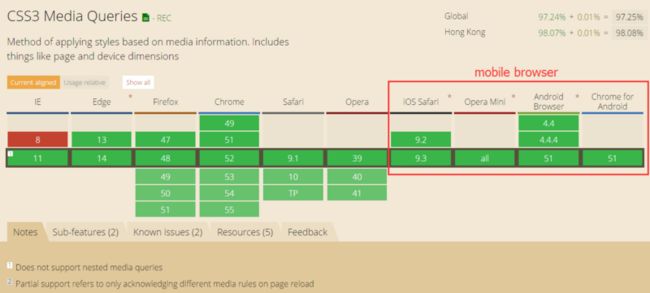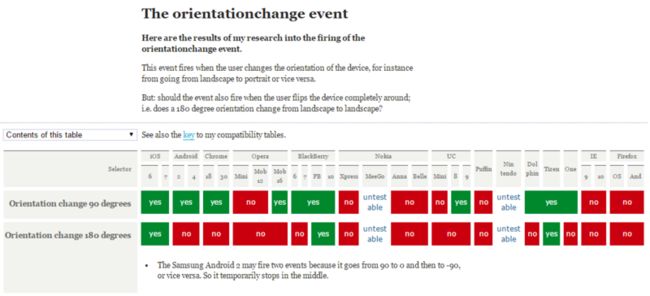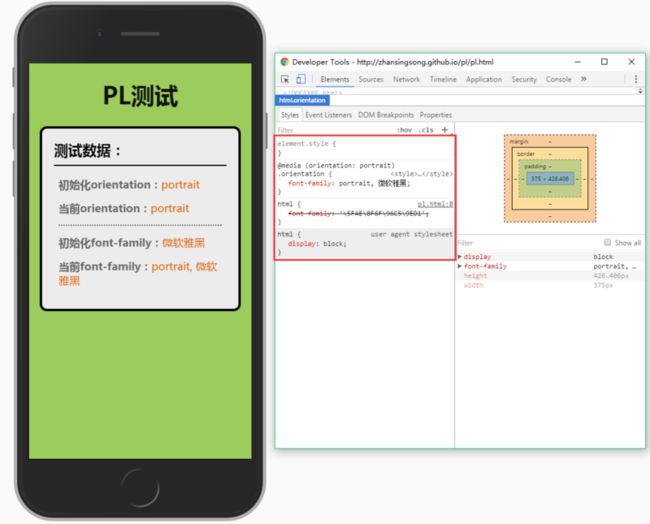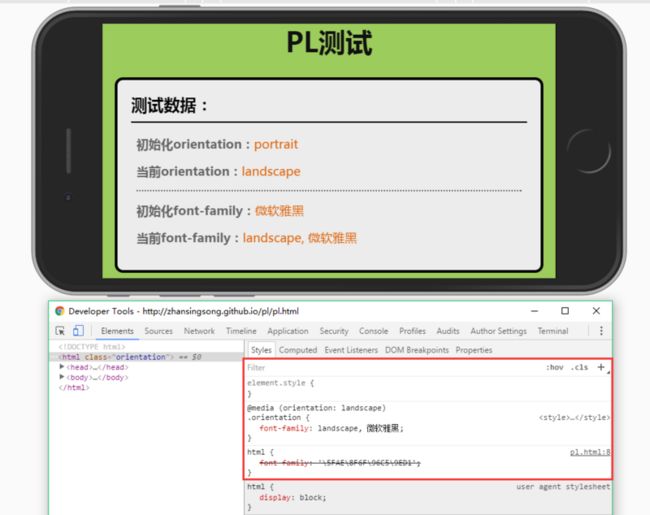前不久,做了一个H5项目,需要在横竖屏变化时,做一些处理。毫无疑问,需要使用orientationchange来监听横竖屏的变化。
方案一:
// 监听 orientation changes
window.addEventListener("orientationchange", function(event) {
// 根据event.orientation|screen.orientation.angle等于0|180、90|-90度来判断横竖屏
}, false);代码添加上后,就各种兼容性问题。这里兼容性问题出现在两个地方:
orientationchangeevent.orientation|screen.orientation.angle
如下是orientationchange事件的兼容性:
如下是screen.orientation的兼容性:
方案二:
上述方案不行,只能另行他法了。google一下,了解到可以通过resize配合(window.inner/outerWidth, window.inner/outerHeight)来实现:
window.addEventListener("resize", function(event) {
var orientation=(window.innerWidth > window.innerHeight)? "landscape":"portrait";
if(oritentation === 'portrait'){
// do something ……
} else {
// do something else ……
}
}, false);这种方案基本满足大部分项目的需求,但是还是有些不足之处:
只要window的size变化,就会不断触发触发
resize事件。可以使用setTimeout来优化一下如果有多个地方需要监听横竖屏,就需要注册多个
window.addEventListener("resize", function(event) {……})。能不能通过订阅与发布模式来改进一下,只注册一个resize负责监听横竖屏变化,只要横竖发生变化就发布通知订阅的对象。其他需要监听横竖屏的地方只需订阅一下即可。
关键代码如下:
var resizeCB = function(){
if(win.innerWidth > win.innerHeight){//初始化判断
meta.init = 'landscape';
meta.current = 'landscape';
} else {
meta.init = 'portrait';
meta.current = 'portrait';
}
return function(){
if(win.innerWidth > win.innerHeight){
if(meta.current !== 'landscape'){
meta.current = 'landscape';
event.trigger('__orientationChange__', meta);
}
} else {
if(meta.current !== 'portrait'){
meta.current = 'portrait';
event.trigger('__orientationChange__', meta);
}
}
}
}();完整代码猛击这里
方案三:
不过个人觉得通过window.innerWidth > window.innerHeight来实现的是一种伪检测,有点不可靠。 可不可以通过浏览器来实现检测?如基于CSS3@media媒体查询来实现。
如下@media兼容性:
如上上图所示,移动端浏览器都支持CSS3 media。
实现思路:
创建包含标识横竖屏状态的特定css样式
通过JS向页面中注入CSS代码
resize回调函数中获取横竖屏的状态
这里我选择的节点font-family作为检测样式属性。理由如下:
选择
主要为了避免reflow和repaint选择
font-family样式,主要是因为font-family有如下特性:
优先使用排在前面的字体。
如果找不到该种字体,或者该种字体不包括所要渲染的文字,则使用下一种字体。
如果所列出的字体,都无法满足需要,则让操作系统自行决定使用哪种字体。
这样我们就可以指定特定标识来标识横竖屏的状态,不过需要将指定的标识放置在其他字体的前面,这样就不会引起hmtl字体的变化。
关键代码如下:
// callback
var resizeCB = function() {
var hstyle = win.getComputedStyle(html, null),
ffstr = hstyle['font-family'],
pstr = "portrait, " + ffstr,
lstr = "landscape, " + ffstr,
// 拼接css
cssstr = '@media (orientation: portrait) { .orientation{font-family:' + pstr + ';} } @media (orientation: landscape) { .orientation{font-family:' + lstr + ';}}';
// 载入样式
loadStyleString(cssstr);
// 添加类
html.className = 'orientation' + html.className;
if (hstyle['font-family'] === pstr) { //初始化判断
meta.init = 'portrait';
meta.current = 'portrait';
} else {
meta.init = 'landscape';
meta.current = 'landscape';
}
return function() {
if (hstyle['font-family'] === pstr) {
if (meta.current !== 'portrait') {
meta.current = 'portrait';
event.trigger('__orientationChange__', meta);
}
} else {
if (meta.current !== 'landscape') {
meta.current = 'landscape';
event.trigger('__orientationChange__', meta);
}
}
}
}();完整代码猛击这里
测试效果
方案四:
可以再改进一下,在支持orientationchange时,就使用原生的orientationchange,不支持则使用方案三。
关键代码如下:
// 是否支持orientationchange事件
var isOrientation = ('orientation' in window && 'onorientationchange' in window);
// callback
var orientationCB = function(e) {
if (win.orientation === 180 || win.orientation === 0) {
meta.init = 'portrait';
meta.current = 'portrait';
}
if (win.orientation === 90 || win.orientation === -90) {
meta.init = 'landscape';
meta.current = 'landscape';
}
return function() {
if (win.orientation === 180 || win.orientation === 0) {
meta.current = 'portrait';
}
if (win.orientation === 90 || win.orientation === -90) {
meta.current = 'landscape';
}
event.trigger(eventType, meta);
}
};
var callback = isOrientation ? orientationCB() : (function() {
resizeCB();
return function() {
timer && win.clearTimeout(timer);
timer = win.setTimeout(resizeCB, 300);
}
})();
// 监听
win.addEventListener(isOrientation ? eventType : 'resize', callback, false);完整代码猛击这里
方案五:
目前,上述几种方案都是通过自定制的订阅与发布事件模式来实现的。这里可以基于浏览器的事件机制,来模拟orientationchange。即对orientationchange的不兼容进行修复。
关键代码如下:
var eventType = 'orientationchange';
// 触发原生orientationchange
var fire = function() {
var e;
if (document.createEvent) {
e = document.createEvent('HTMLEvents');
e.initEvent(eventType, true, false);
win.dispatchEvent(e);
} else {
e = document.createEventObject();
e.eventType = eventType;
if (win[eventType]) {
win[eventType]();
} else if (win['on' + eventType]) {
win['on' + eventType]();
} else {
win.fireEvent(eventType, e);
}
}
}完整代码猛击这里
通过上述5种方案,自己对移动端横竖屏检测有了更进一步的认识,有些东西只有自己亲身经历过才知道为什么要这么写,自己也把其中缘由记录在文章中,希望对大家有帮助。经过5种方案的演变得到了最终orientationchange-fix,github地址:https://github.com/zhansingsong/orientationchange-fix



